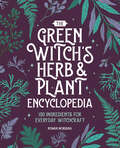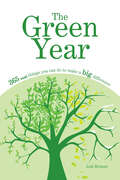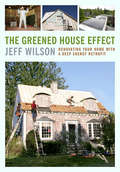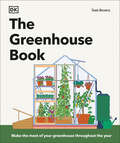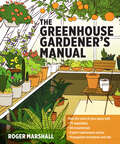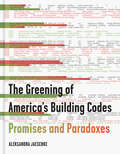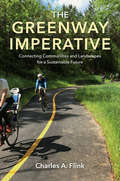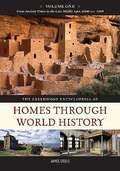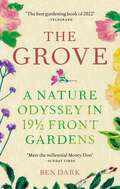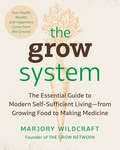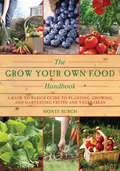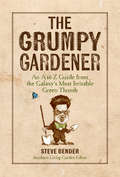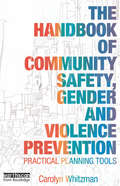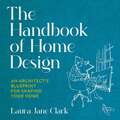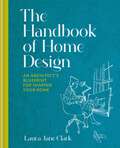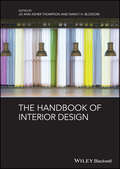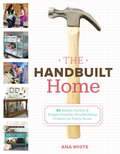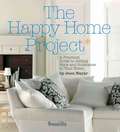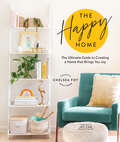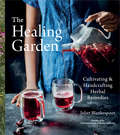- Table View
- List View
The Green Witch's Herb and Plant Encyclopedia: 150 Ingredients for Everyday Witchcraft
by Rowan MorganaEverything you need to know about using plants and herbs for green witchcraftInfusing your craft with plants and herbs is a powerful way to connect to Mother Earth. This green witchcraft encyclopedia explores the most essential magical plants, offering you a complete resource for safely growing, foraging, harvesting, and using everything from aloe to valerian. Discover greater harmony with nature as you harness the natural energy of plants to create healing and balance in your life.150 plant profiles — Find detailed entries for the plants and herbs green witches use the most, including photos, explanations of each plant's magical properties, and tips for how to grow them yourself.Herb magic in action — Experience the power of plant magic with spells and rituals to try, such as banishing negativity with catnip and clover or building a fairy altar with foxglove and thyme.Embrace your inner witch — Part reference guide and part grimoire, this book of herbs helps you develop your practice by exploring how to set intentions, create a sacred space, and maintain your own garden.Start your own witch's apothecary and create some everyday magic with this encyclopedia of magical herbs and plants.
The Green Year: 365 Small Things You Can Do to Make a Big Difference
by Jodi HelmerGo green one day at a time. Do something every day. Most of us want to do the right thing for the environment, but making the commitment to change our fast-paced, convenience-oriented lifestyles can be more than a little daunting. What&’s the answer? Take that giant commitment and cut it up into 365 little commitments that get met one day at a time. The Green Year does just that. More than a calendar, it offers simple, practical, affordable, and engaging activities that make going green a blessing rather than a burden. In addition to these easy green suggestions, readers will find in The Green Year: • The &“why&” behind each activity—what makes it good for the environment and the reader? • A quick &“how-to&” for any activity that requires it • Room for readers to write in their own creative alternatives • Helpful illustrations
The Greened House Effect
by Jeff WilsonWith greater public awareness of the need for energy independence, the issue of how we can make our existing homes more resource efficient is becoming ever more critical. Residential buildings make up a large fraction of our energy needs, largely due to heating and air-conditioning. So it's no longer enough to simply do the small stuff, like switching to compact fluorescent bulbs, or turning down the thermostat at night. In The Greened-House Effect, author Jeff Wilson brings his twenty-five years of construction experience and knowledge of home building to bear on making our current houses cleaner, greener, and healthier. Think of a deep-energy retrofit (DER) as a "home makeover" - one that represents a significant investment, but that saves money from the get-go by capturing the energy you "drop on the ground" every month, every year, through inefficiency, poor design, or simply living in a typical older home. Using his own family's DER of their 1942 home as a prime example, Wilson weaves a readable narrative at a practical, hammer-and-nail level. He presents the solutions to our building and energy problems, making them seem possible for average homeowners and small contractors by offering the right set of information, skills, and materials. More technical information is presented in sidebars and graphs, and numerous color photos illustrate the process, including: Testing the energy efficiency of your home and learning where improvements need to be made Issues of local building codes and regulations Financing and paying for a DER Major components of the DER, such as roofs, exterior walls, basements, and home systems Wilson's building experience, along with his lifelong passion for energy issues, all come together to form an inspirational, can-do approach to making our neighborhood, our community, our nation, and our world a better place - one home at a time.
The Greenhouse Book: Make the Most of Your Greenhouse Throughout the Year
by Tom BrownThe ultimate guide to gardening under glass.Thinking of buying a greenhouse but aren't sure what to grow in it, or how? Or maybe you've inherited a garden with a greenhouse, but haven't got a clue what to do with it? Whatever your journey to growing under glass, this book gives a clear, inspiring, and brilliantly illustrated approach to all things greenhouse.A protected growing environment provides shelter and warmth to a broad range of tender plants, both edible and ornamental, and can open up a fascinating new world of gardening. Starting plants off early under glass also enables you to extend the growing season, providing additional weeks and months of homegrown, sustainable produce to enjoy and flowers to admire.From initial planning considerations and ongoing maintenance to all the exciting and unusual plants that can be grown; from overwintering exotics, to hardening off seedlings and protecting summer crops against pests and diseases, there is a wealth of information to be shared. And you don't need a large garden: with a patio greenhouse, cold frame, and cloches, anyone with outside space can enjoy growing under glass.
The Greenhouse Gardener's Manual
by Roger MarshallImagine biting into a fresh, juicy tomato straight from the vine in the middle of winter or growing a collection of succulents and cacti the coldest parts of the world. In The Greenhouse Gardener's Manual, Roger Marshall providesevery tool and technique you need to successfully grow edibles and ornamentals in a well-maintained greenhouse. Marshall offers insight to choose the right greenhouse, create a healthy environment, start seeds and propagate, and maintain your greenhouse.
The Greening of America's Building Codes: Promises and Paradoxes
by Aleksandra JaeschkeEnvironmental disasters and severe weather due to climate change, both triggered by human actions, have had an increasingly direct impact on our homes. But the way in which America builds its homes is part of the problem. This deeply researched history of sustainable design standards in building codes explores how public policy, standard-setting trade associations, and financial incentives influence the ways in which the construction of our homes impacts the environment.The Greening of America's Building Codes investigates the regulations and economic incentives meant to control the environmental impact of contemporary construction practices as it analyzes the history of residential building codes. The book exposes how the socioeconomic and political forces that influenced early building code development continue to define the character of current building codes and, by extension, determine how we regulate environmental impact and define sustainability today.More relevant than ever, The Greening of America's Building Codes is a valuable tool for architects, architecture students, builders, real estate developers, and homeowners who want to understand how public policy and their own day-to-day decisions impact the environment.
The Greenway Imperative: Connecting Communities and Landscapes for a Sustainable Future
by Charles A. FlinkTrailblazing greenway projects from vision to reality In this eye-opening journey through some of America’s most innovative landscape architecture projects, Charles Flink shows why we urgently need greenways. A leading authority in greenway planning, design, and development, Flink presents inspiring examples of communities that have come together to build permanent spaces for the life-sustaining power of nature. The Greenway Imperative reveals the stories behind a variety of multiuse natural corridors, taking readers to Grand Canyon National Park, suburban North Carolina, the banks of the Miami River, and many other settings. Flink, who was closely involved with each of the projects in this book during his 35-year career, introduces the people who jumpstarted these initiatives and the challenges they overcame in achieving them. Flink explains why open green spaces are increasingly critical today. “Much more than a path through the woods,” he says, greenways conserve irreplaceable real estate for the environment, serve as essential green infrastructure, shape the way people travel within their communities, reduce impact from flooding and other natural disasters, and boost the economies of cities and towns. Greenways can and should dramatically reshape the landscape of America in the coming years, Flink argues. He provides valuable reflections and guidance on how we can create resilient communities and satisfy the human need for connection with the natural world.
The Greenwood Encyclopedia of Homes Through World History, Volume 1: From Ancient Times to the Late Middle Ages, 6000 BCE–1200
by James SteeleSteele (author and educator, U. of Southern California) provides a comprehensive survey of the housing of significant cultures from throughout the world: the Americas, Africa, Asia and Australasia, East and Southeast Asia, and Europe and the Western Mediterranean. The three-volume set spans the development of housing from ancient times to the present. While the author discusses materials used and methods of construction, he also delves into how the housing of different societies reflects their belief systems, social orders, and cultures. From the relatively familiar stone structures of Macchu Picchu to the Chinese residential districts known as hutongs, the array of architectural styles and the considerations incorporated into their construction--such as environment, light, protection, and available materials--provide a fascinating journey through history. Organized in an encyclopedic format, the set is clearly written, informative, and well-illustrated. Annotation ©2009 Book News, Inc., Portland, OR (booknews.com)
The Greenwood Encyclopedia of Homes Through World History, Volume 2: The Renaissance to the Industrial Revolution, 1201–1750
by James SteeleSteele (author and educator, U. of Southern California) provides a comprehensive survey of the housing of significant cultures from throughout the world: the Americas, Africa, Asia and Australasia, East and Southeast Asia, and Europe and the Western Mediterranean. The three-volume set spans the development of housing from ancient times to the present. While the author discusses materials used and methods of construction, he also delves into how the housing of different societies reflects their belief systems, social orders, and cultures. From the relatively familiar stone structures of Macchu Picchu to the Chinese residential districts known as hutongs, the array of architectural styles and the considerations incorporated into their construction--such as environment, light, protection, and available materials--provide a fascinating journey through history. Organized in an encyclopedic format, the set is clearly written, informative, and well-illustrated. Annotation ©2009 Book News, Inc., Portland, OR (booknews.com)
The Greenwood Encyclopedia of Homes Through World History, Volume 3: The Industrial Revolution to Today, 1751 to the Present
by James SteeleSteele (author and educator, U. of Southern California) provides a comprehensive survey of the housing of significant cultures from throughout the world: the Americas, Africa, Asia and Australasia, East and Southeast Asia, and Europe and the Western Mediterranean. The three-volume set spans the development of housing from ancient times to the present. While the author discusses materials used and methods of construction, he also delves into how the housing of different societies reflects their belief systems, social orders, and cultures. From the relatively familiar stone structures of Macchu Picchu to the Chinese residential districts known as hutongs, the array of architectural styles and the considerations incorporated into their construction--such as environment, light, protection, and available materials--provide a fascinating journey through history. Organized in an encyclopedic format, the set is clearly written, informative, and well-illustrated. Annotation ©2009 Book News, Inc., Portland, OR (booknews.com)
The Grove: A Nature Odyssey in 19 ½ Front Gardens
by Ben Dark***'Ben Dark is such a wonderful writer - The Grove drew me in from the first line.' Lia Leendertz'The Grove is overflowing with delicious nuggets of cultural, social and garden history - and I adore Ben Dark's humour and humility in equal measure.' Advolly Richmond'A heartfelt romp through the wisteria and wilderness of London's horticulturally remarkable front gardens.' Jack Wallington'Fans of Ben Dark's mellifluous tones on The Garden Log podcast will be delighted by how perfectly his lyrical musings transfer to the printed page as, with infant son in tow, he invites the reader upon a series of horticultural expeditions inspired by the deceptively ordinary planting of the front gardens in a south London street. The kind of thoroughly enjoyable read where you realise, late in the day, that learning has snuck in by the back door, though you feel inclined to forgive the author on account of the fun you've had along the way.'Andrew O'Brien'Any walk is an odyssey when we connect with the plants around us. Each tree or flower tells a tale. Mundane 'suburban' shrubs speak of war and poetry, of money, fashion, love and failure. Every species in this book was seen from one pavement over twelve months and there is little here that could not be found on any road in any town, but they reveal stories of such weirdness, drama, passion and humour that, once discovered, familiar neighbourhoods will be changed forever.' Ben DarkThere is a renewed interest in the nature on our doorsteps, as can be seen in the work of amateur botanists identifying wildflowers and chalking the names on the pavements.But beyond the garden wall lies a wealth of cultivated plants, each with a unique tale to tell. In The Grove, award-winning writer and head gardener Ben Dark reveals the remarkable secrets of twenty commonly found species - including the rose, wisteria, buddleja, box and the tulip - encountered in the front gardens of one London street over the course of year. As Ben writes, in those small front gardens 'are stories of ambition, envy, hope and failure' and The Grove is about so much more than a single street, or indeed the plants found in its 19 ½ front gardens. It's a beguiling blend of horticultural history and personal narrative and a lyrical exploration of why gardens and gardening matter.
The Grove: A Nature Odyssey in 19 ½ Front Gardens
by Ben Dark***'Ben Dark is such a wonderful writer - The Grove drew me in from the first line.' Lia Leendertz'The Grove is overflowing with delicious nuggets of cultural, social and garden history - and I adore Ben Dark's humour and humility in equal measure.' Advolly Richmond'A heartfelt romp through the wisteria and wilderness of London's horticulturally remarkable front gardens.' Jack Wallington'Fans of Ben Dark's mellifluous tones on The Garden Log podcast will be delighted by how perfectly his lyrical musings transfer to the printed page as, with infant son in tow, he invites the reader upon a series of horticultural expeditions inspired by the deceptively ordinary planting of the front gardens in a south London street. The kind of thoroughly enjoyable read where you realise, late in the day, that learning has snuck in by the back door, though you feel inclined to forgive the author on account of the fun you've had along the way.'Andrew O'Brien'Any walk is an odyssey when we connect with the plants around us. Each tree or flower tells a tale. Mundane 'suburban' shrubs speak of war and poetry, of money, fashion, love and failure. Every species in this book was seen from one pavement over twelve months and there is little here that could not be found on any road in any town, but they reveal stories of such weirdness, drama, passion and humour that, once discovered, familiar neighbourhoods will be changed forever.' Ben DarkThere is a renewed interest in the nature on our doorsteps, as can be seen in the work of amateur botanists identifying wildflowers and chalking the names on the pavements.But beyond the garden wall lies a wealth of cultivated plants, each with a unique tale to tell. In The Grove, award-winning writer and head gardener Ben Dark reveals the remarkable secrets of twenty commonly found species - including the rose, wisteria, buddleja, box and the tulip - encountered in the front gardens of one London street over the course of year. As Ben writes, in those small front gardens 'are stories of ambition, envy, hope and failure' and The Grove is about so much more than a single street, or indeed the plants found in its 19 ½ front gardens. It's a beguiling blend of horticultural history and personal narrative and a lyrical exploration of why gardens and gardening matter.
The Grow System: True Health, Wealth, and Happiness Come from the Ground
by Marjory WildcraftGrow your own food and medicine with a step-by-step guide from the founder of The Grow NetworkImagine cultivating enough food to slash your grocery shopping in half--all in less than an hour a day in your own backyard. Sounds impossible, right? Marjory Wildcraft says it's not: She's been homesteading for almost twenty years and founded The Grow Network to teach hundreds of thousands of others--some with very little space or time, some city dwellers with rooftop gardens--how to do the same, from gardening, to raising chickens, to composting, to medicine-making.Wildcraft started her homesteading journey in search of a more sustainable and financially secure way of life. As she says, self-sufficiency offers practical rewards, but the real payoff is "true wealth": health, family, community, meaningful work, and living a life with purpose. This empowering way of life is possible for anyone who has a patch of dirt, small or large. The Grow System includes: • Essential advice for creating a balanced ecosystem in your backyard, with a basic recipe for homemade fertilizer • Step-by-step instructions for setting up a chicken coop and information on choosing the right breed • Home remedies for 12 common ailments, with 8 must-know medicine preparations. The Grow System provides a comprehensive strategy for producing healthy food and herbal medicine at home, and reclaiming the skills our ancestors used every day. It helps connect us to the environment and empowers us to lead healthier lives, without relying on big systems that are out of our control and insecure. It offers a path to a rich, reliable, and deeply satisfying life.
The Grow Your Own Food Handbook: A Back to Basics Guide to Planting, Growing, and Harvesting Fruits and Vegetables (Handbook Series)
by Monte BurchGrowing your own food is a hot topic today because of the high cost of transporting food long distances, the heightened problem of diseases caused by commercially grown foods, concerns of the overuse of chemicals in mass food production, and the uncertain health effects of GMOs. Many people-from White House executives to inner-city kids-have recently discovered the benefits of homegrown vegetables and fruits. Community gardens, and even community canning centers, are increasingly popular and have turned roof-top gardening into a great and healthy food source. And on a smaller scale, some plants can even be grown in containers for the smallest backyard or patio. The possibilities for growing your own food are endless!The Grow Your Own Food Handbook informs you how to grow all types of vegetables, fruits, and even grains on your own land or in any small space available to you and your family. Also included is information on specific health benefits, vitamins, and minerals for each food, as well as detailed instructions for fall and winter food growing. Learn how to grow for your family, harvest and store all types of home-grown produce, and find joy in eating foods planted with your own hands.
The Grumpy Gardener: An A to Z Guide from the Galaxys Most Irritable Green Thumb
by Steve BenderGardeners from across the country have turned to Southern Living Senior Garden Editor Steven Bender - known affectionately as "The Grumpy Gardener" - for his keen knowledge and gardening know-how with equal doses sarcasm and sidesplitting humor for nearly 35 years. Finally, the collected wit and wisdom of the magazine's most irreverent and beloved columnist can be found in a single A - Z volume, providing gardeners from coast-to-coast with his valuable tips for planting, troubleshooting, and growing flowers, vegetables, shrubs, trees and more, all delivered in his signature cantankerous style. Sidebars throughout the book - "Ask Grumpy" - help readers tackle common garden problems ("How do I get ride of little house ants?"), and readers from the past 35 years take part in the book when Grumpy shares his favorite reader's responses to some of his advice, his favorite rules for gardening, and Q & A's covering your favorite plants and flowers are all inside. Additionally, beautiful line-drawings and illustrations throughout make the book as beautiful to look at as well as entertaining to read. The Grumpy Gardener is sure to become the most trusted tool in your gardening shed!
The Handbook of Community Safety Gender and Violence Prevention: Practical Planning Tools
by Carolyn WhitzmanViolence and insecurity are among the most important issues facing communities in the 21st century. Both family violence and community violence are rapidly rising in the urbanizing nations of theSouth and richer nations are also facing increased concern about the health, social, economic and environmental costs of violence and crime. The Handbook of Community Safety, Gender and Violence Prevention is the first book to gather together research and examples, from a gendered perspective, of local, regional and international interventions that work to prevent crime, violence and insecurity. Case studies of successful initiatives from every continent, in settings that vary from large cities to rural areas, are analysed to provide cross-cultural lessons of what works and what doesn t. The book presents essential practical advice to professionals such as: how to obtain diagnostic information on incidence and impacts of violence; how to develop, maintain and evaluate policies and programmes that can effectively promote community safety; and how to create trust and effectiveness in partnerships.
The Handbook of Home Design: An Architect’s Blueprint for Shaping your Home
by Laura Jane ClarkArchitectural solutions & designs to optimize the spaces in your home without spending a fortune.Architect Laura Jane Clark, from the BBC and Netflix smash-hit series Your Home Made Perfect, has spent over 15 years designing, remodelling, and building homes with budgets that range from modest to enormous. THE HANDBOOK OF HOME DESIGN distils Laura's wealth of experience and enthusiasm giving you an accessible yet detailed guide to design, empowering you with the tools and knowledge to shape your home how you want. Throughout your home design journey, whether large or small, Laura takes you each step of the way from understanding your home, reading a plan and writing a brief, right through to sketching your own design and having the confidence to get what you want on the building site. Packed full of tips and tricks, inspiration and technical know-how, THE HANDBOOK OF HOME DESIGN is like having Laura by your side, showing you how to design practical yet beautiful spaces, get more storage into your life and create the home of your dreams.Laura Jane Clark wants to democratize the whole concept of residential architectural design and empower you to redesign your spaces by giving you the language and ability to confidently communicate your vision, get the most out of your design and ultimately love your finished home. Whether you are a long-term homeowner, first-time buyer or simply visualising your dream space, no matter what your budget is, this unique insight into Laura's process allows you to achieve both the design you want and the home you need.www.lamparchitects.co.uk Instagram: @laurajaneclark_(p) 2023 Octopus Publishing Group
The Handbook of Home Design: An Architect’s Blueprint for Shaping your Home
by Laura Jane ClarkArchitectural solutions & designs to optimize the spaces in your home without spending a fortune.Architect Laura Jane Clark, from the BBC and Netflix smash-hit series Your Home Made Perfect, has spent over 15 years designing, remodelling, and building homes with budgets that range from modest to enormous. THE HANDBOOK OF HOME DESIGN distils Laura's wealth of experience and enthusiasm giving you an accessible yet detailed guide to design, empowering you with the tools and knowledge to shape your home how you want. Throughout your home design journey, whether large or small, Laura takes you each step of the way from understanding your home, reading a plan and writing a brief, right through to sketching your own design and having the confidence to get what you want on the building site. Packed full of tips and tricks, inspiration and technical know-how, THE HANDBOOK OF HOME DESIGN is like having Laura by your side, showing you how to design practical yet beautiful spaces, get more storage into your life and create the home of your dreams.Laura Jane Clark wants to democratize the whole concept of residential architectural design and empower you to redesign your spaces by giving you the language and ability to confidently communicate your vision, get the most out of your design and ultimately love your finished home. Whether you are a long-term homeowner, first-time buyer or simply visualising your dream space, no matter what your budget is, this unique insight into Laura's process allows you to achieve both the design you want and the home you need.www.lamparchitects.co.uk Instagram: @laurajaneclark_
The Handbook of Home Design: An Architect’s Blueprint for Shaping your Home
by Laura Jane ClarkArchitectural solutions & designs to optimize the spaces in your home without spending a fortune.Architect Laura Jane Clark, from the BBC and Netflix smash-hit series Your Home Made Perfect, has spent over 15 years designing, remodelling, and building homes with budgets that range from modest to enormous. THE HANDBOOK OF HOME DESIGN distils Laura's wealth of experience and enthusiasm giving you an accessible yet detailed guide to design, empowering you with the tools and knowledge to shape your home how you want. Throughout your home design journey, whether large or small, Laura takes you each step of the way from understanding your home, reading a plan and writing a brief, right through to sketching your own design and having the confidence to get what you want on the building site. Packed full of tips and tricks, inspiration and technical know-how, THE HANDBOOK OF HOME DESIGN is like having Laura by your side, showing you how to design practical yet beautiful spaces, get more storage into your life and create the home of your dreams.Laura Jane Clark wants to democratize the whole concept of residential architectural design and empower you to redesign your spaces by giving you the language and ability to confidently communicate your vision, get the most out of your design and ultimately love your finished home. Whether you are a long-term homeowner, first-time buyer or simply visualising your dream space, no matter what your budget is, this unique insight into Laura's process allows you to achieve both the design you want and the home you need.www.lamparchitects.co.uk Instagram: @laurajaneclark_
The Handbook of Interior Design
by Jo Ann Asher Thompson Nancy H. BlossomThe Handbook of Interior Design explores ways of thinking that inform the discipline of interior design. It challenges readers to consider the connections within theory, research, and practice and the critical underpinnings that have shaped interior design. Offers a theory of interior design by moving beyond a descriptive approach to the discipline to a 'why and how' study of interiors Provides a full overview of the most current Interior Design research and scholarly thought from around the world Explores examples of research designs and methodological approaches that are applicable to interior design upper division and graduate education courses Brings together an international team of contributors, including well established scholars alongside emerging voices in the field – reflecting mature and emergent ideas, research, and philosophies in the field Exemplifies where interior design sits in its maturation as a discipline and profession through inclusion of diverse authors, topics, and ideas
The Handbuilt Home: 34 Simple Stylish and Budget-Friendly Woodworking Projects for Every Room
by Ana WhiteCreate a Beautiful, Modern Home with One-of-a-Kind DIY FurnitureBeds, organizers, Adirondack chairs, a play table, and more! It's easy to build inexpensive, quality furnishings with this indispensible collection of woodworking projects from Ana White, the popular blogger who has inspired millions of homemakers with her stylish furniture plans and DIY spirit. As a young mom on a tight budget, Ana learned to make her own well-designed pieces inspired by the styles in her favorite stores--saving thousands of dollars in the process.Now, in this reference for woodworkers of all skill levels, Ana shares everything she has learned along the way. Inside The Handbuilt Home you'll find:* Plans for 34 versatile furniture projects for every room in your house--from beginner-friendly home accessories to sturdy tables, a media center, kids' items, and storage solutions* Comprehensive information on using off-the-shelf lumber and basic equipment--almost every project can be made with a drill, a saw, and some hand tools* Easy-to-follow instructions, costs, and time estimates to guide even the most amateur of carpenters through any projectYou don't need to be physically tough or superstrong to make your own furniture, and it's okay if you don't know that a 2x4 doesn't actually measure 2 by 4 inches. All you need is the determination to create a better home for yourself or your family and the confidence to say, "I can build that." Also available as an eBook
The Hands-On Home
by Charity Burggraaf Erica StraussWant to create an organized, productive, and beautiful kitchen and home? Popular Seattle blogger, Erica Strauss (Northwest Edible Life) shows us how in this modern homekeeping handbook for thrifty DIYers who care about sustainability. A fresh take on modern homemaking, this is a practical (and sometimes sassy) guide to maximizing your time, effort, and energy in the kitchen and beyond. With a focus on less consumerism, it will teach you how to organize your kitchen and home to make the best use of your time. For those yearning to live a more ecologically minded, grounded lifestyle, this book is full of practical, no-nonsense advice, fabulous recipes, and time- and money-saving techniques.From the Hardcover edition.
The Happy Home Project
by Jean NayarWe all want beautiful homes that reflect our personal style. But the happiest homes don't just look good-they also feel good. Ideally, they support the way we live, keep us healthy and safe and enrich our net worth, too. So how do we create homes that truly make us happy? In The Happy Home Project, author Jean N ayar looks not only at the material things that contribute to the beauty and style of a house, but also explores the hidden elements and intangibles that add to its substance and soul. Brimming with beautiful photos and filled with expert advice from architects, designers, organizing experts, and contractors, the book offers easy-to-follow guidance on how to create inspiring, stylish rooms as well as practical tips on how to invest wisely in furniture and improvements that will add value to your home-and your quality of life. Focusing on comfort and harmony with nature, the book taps into the wisdom of poets, philosophers and social scientists-as well as experts of the ancient Asian building philosophies of feng shui, vastu shastra, and wabi-sabi-to reveal some of the subtler steps that anyone can take to turn to an ordinary, impersonal house into an uplifting, personal sanctuary.With helpful hints on everything from corralling clutter, picking paint and arranging furniture to refinishing floors, replacing windows and remodeling a kitchen, The Happy Home Project is a great go-to guide for home improvement projects, large and small. Whether your home needs a major makeover or just a little fine-tuning, the ideas, solutions and tips in this book will help you increase its happiness quotient-and let you live well in any dwelling and at any stage of life.
The Happy Home: The Ultimate Guide to Creating a Home that Brings You Joy
by Chelsea FoyThis lovely and inspirational guide, organized around six joyful qualities, will show you how to create a happier home, through prompts, quick fixes, afternoon projects, and mindful design and organization—The Happy Home is not just a title, it&’s a promise.Energize. Uplift. Comfort. Calm. Empower. Express. The road to happiness is paved with good emotions. In fact, a happy home is infused with these six actions and this cheerful book will help you create a space you love and that loves you back. Lovely Indeed creator Chelsea Foy offers up more than 50 creative ideas to engage all the senses to brighten your mood throughout your home. This book sits at the intersection of HGTV home improvements and design, thoughtful Marie Kondo practices, and a cheery color palette fans of the Home Edit will love.Kicking off with a foreword by Joy Cho, creator of Oh Joy!, the book guides you through questions to consider so you can customize your home to your own mood-lifting needs, be it a calming bedroom, a chill den, or an energizing kitchen. Easy projects and ideas help you tweak the rooms of your house so they engage the senses in all the right ways.Each chapter focuses on a feeling and includes: Guided prompts: Questions to consider about what a happy space might look and feel like for youQuick Tricks: Creative hacks and ideas to freshen up your spaceAfternoon Projects: Doable projects and inspo for your home and décor to amp up the joy Big Ideas: Step-by-step projects that you can complete in a day or weekend that are inexpensive but go a long way to creating a home tailored to your tastes and happiness needs With this handy and cheery book, you'll quickly find ways to customize all the rooms in your house for maximum bliss.
The Healing Garden: Cultivating and Handcrafting Herbal Remedies
by Juliet BlankespoorA comprehensive and lushly photographed guide to growing and using healing plants, including recipes, from the founder of the Chestnut School of Herbal MedicineThis is the ultimate reference for anyone looking to bring the beauty and therapeutic properties of plants into their garden, kitchen, and home apothecary. Both informative and accessible, it covers how to plan your garden (including container gardening for small spaces); essential information on seed propagation, soil quality, and holistic gardening practices; 30 detailed profiles of must-know plants (including growing information, medicinal properties, and how to use them); foundational principles of herbalism; step-by-step photographic tutorials for preparing botanical medicine and healing foods; and 70 recipes for teas, tinctures, oils, salves, syrups, and more. Packed with sumptuous photography, this book will appeal to home gardeners who want to branch out to culinary and medicinal herbs, home cooks and those interested in natural wellness, and novice and skillful herbalists alike.
